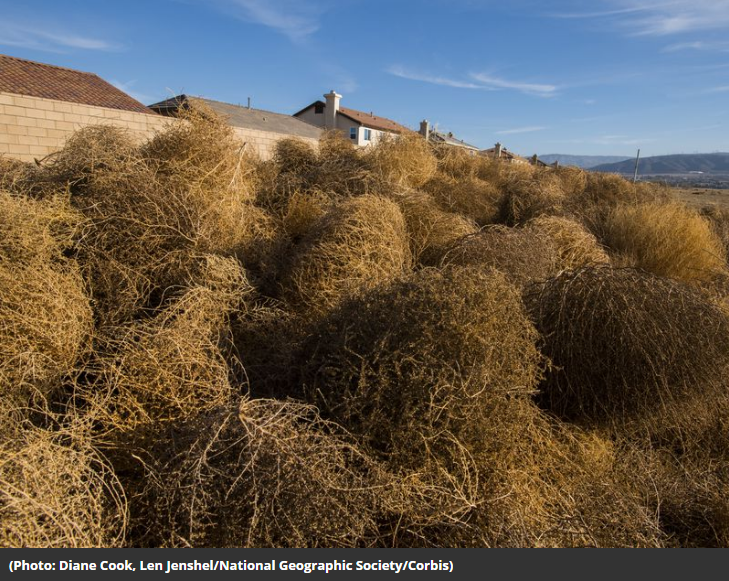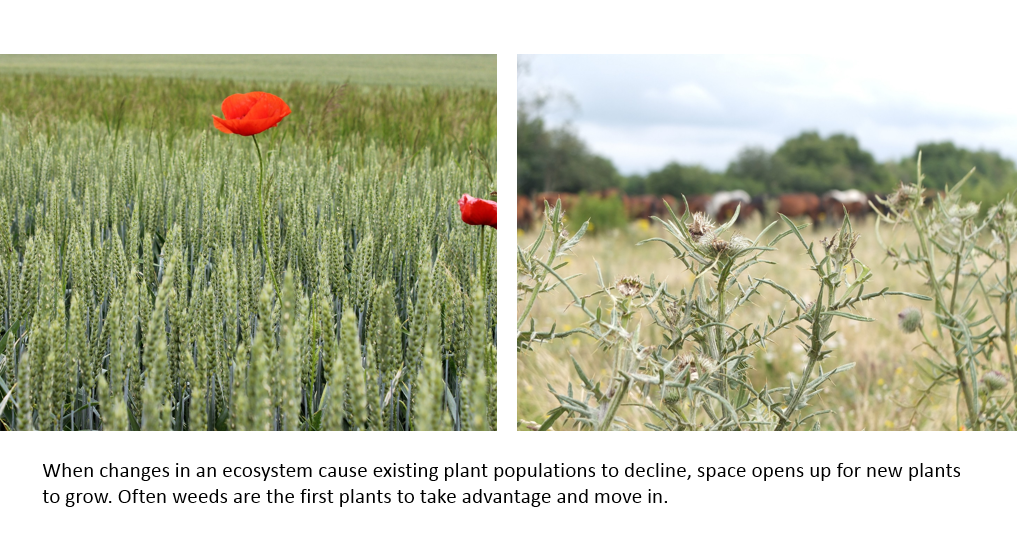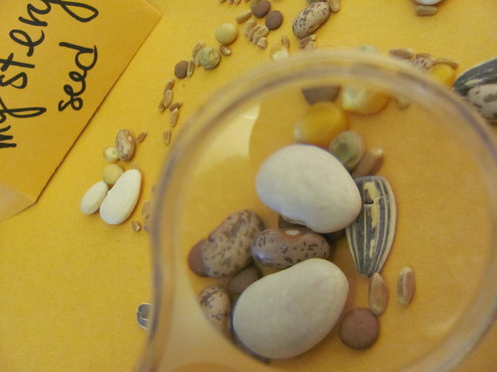Agricultural Literacy Curriculum Matrix
Lesson Plan
Crop Case Files: Dichotomous Keys
Grade Level
Purpose
Students will explore the connection between weeds and ecosystem stability, practice observing characteristics by using and creating a dichotomous key, and research and present information on noxious weeds. Grades 6-8
Estimated Time
Materials Needed
Engage:
- America's Tumbleweeds Are Actually Russian Invaders article and associated video
Activity 1:
Activity 2:
- Example of How to Create a Dichotomous Key handout
- Seed Classification Bracket activity sheet
- Seed Classification Dichotomous Key activity sheet
- Folders or manila envelopes labeled “Classified,” 1 per group*
- Small "Mystery" envelopes, 1 per group*
- Samples of up to nine different types of seeds*
- Note: While any seeds will do for this activity, some of the best to work with include seeds from the legume family (soybeans, alfalfa, peas, etc.) as well as seeds that students may be familiar with from the food that they eat that will be available at your local grocery store, including a wide variety of beans, popcorn kernels, pumpkin seeds, and sunflower seeds.
- Magnifying glasses*
*These items are included in the Seed ID Kit, which is available for purchase from agclassroomstore.com.
Vocabulary
dichotomous key: a key for the identification of organisms based on a series of choices between alternative characters
invasive species: a plant, fungus, or animal species that is not native to a specific location (an introduced species), and which has a tendency to spread to a degree believed to cause damage to the environment, human economy or human health
noxious weed: a weed that has been designated by an agricultural authority as one that is injurious to agricultural or horticultural crops, natural habitats or ecosystems, or humans or livestock
taxonomy: a branch of science that encompasses the description, identification, nomenclature, and classification of living or nonliving items for identification
weed: a plant that is not valued where it is growing and is usually of vigorous growth
Did You Know?
- Nearly 250 weed species have developed resistance to the herbicides used to control them.1
- Weeds can promote flooding during hurricanes by jamming control pumps and blocking water flow.1
- Some weeds irritate allergies. Common ragweed (Ambrosia artemisiifolia), for example, can release a billion pollen grains per plant from August through October, triggering allergic reactions for nearly 36 million Americans annually.1
- Some weeds are edible. Examples include borage (Borago officinalis) and dandelion (Taraxacum officinale).1
Background Agricultural Connections
The goal of a single-access or dichotomous key is to take an object or organism that is unknown and, following the key, make a positive identification of the item. Scientists use a detailed language to communicate with precision to others who read their work. Whether the reader is on a different continent or even generations into the future, they should be able to identify the same item using the same classification scheme.
Though classification may seem like a complicated scientific process, it is actually intuitive and useful in both scientific and real-world settings. Taxonomy or taxanomic classification is a practice used by scientists to classify living and nonliving items for the purpose of identification. For example, farmers who grow row crops want to eliminate as many weeds as possible in order to ensure that they can harvest only the plant that they intend to sell. Knowing the identity of the plants in a field, both wanted and unwanted, is important in helping a farmer target and eliminate any weeds that might interfere with their harvest. To make a positive identification, farmers may rely on a dichotomous key, observing characteristics like the presence or absence of a defined stem; the type and texture of the leaves; the kinds of flowers; and the type of fruit, pod, or other seed casing that the plant produces. Every species of plant has its own, individual characteristics; these unique traits are the basis for creating and using a dichotomous key.
Without people, there would be no weeds. A weed is simply a plant that is undesirable to people in the location it is growing. The same plant can be a weed in one location and a desirable crop in another. For example, many homeowners consider dandelions growing in their lawns to be weeds. However, in Italian cuisine, dandelions are considered a desirable vegetable and in other cultures, dandelions are an important medicinal herb.
Most weeds grow and spread aggressively, outcompeting more desirable plants. Many weeds are invasive species, meaning they have been introduced (they are not native) to an environment in which they have a tendency to spread rapidly, causing damage to the environment, human economy, or human health. However, some native species are also considered weeds. Often weeds become a problem in disturbed environments. When a change in the physical or biological components of an ecosystem damages existing plant populations, space opens up for weeds to move in.
Weeds are of particular concern in agriculture. Agricultural ecosystems are regularly disturbed by actions such as tilling and grazing. Farmers and ranchers use a variety of methods to control weeds. These methods can be grouped into five main categories: preventative, cultural, mechanical, biological, and chemical weed control. Preventative controls focus on limiting the spread and establishment of weed seeds. Cultural weed control includes any action that creates conditions that favor desirable plants over weeds, including targeting fertilization and irrigation to the particular needs of the crop. Mechanical weed control includes any action that physically removes, kills, or prevents the growth of weeds. Biological methods focus on using living organisms, such as insects or plant pathogens, to control weed populations, and chemical methods utilize herbicides to kill or interrupt the growth of weeds.
These methods of weed control may also be used by homeowners, public land managers, and others. Some weeds are so problematic that it requires the cooperation of entire communities to control their spread. In 1975 the Federal Noxious Weed Act established a Federal program to control the spread of noxious weeds. Only the most damaging and fastest spreading plants get designated as noxious weeds. Noxious weeds can change habitats, block waterways, poison livestock, reduce farmers harvests, interfere with traffic on roads, and more. The first step in controlling these damaging plants is identification. Teaching students how to use a dichotomous key will equip them to be more responsible stewards of the ecosystems they live and play in.
Engage
- Share the Smithsonian Magazine article America’s Tumbleweeds Are Actually Russian Invaders with students, including the short news video of a town in New Mexico that was buried in tumbleweeds.
- Use guiding questions to connect the article and video to ecology concepts:
- What characteristics make the tumbleweed a weed? (it grows and spreads quickly; it’s undesirable and does not serve any useful purpose—it is not an important source of food for people or animals)
- Where did the tumbleweed originally come from? (Russia)
- How does the tumbleweed spread? (wind; when the plant has matured, it dies and dries out; its shape makes it easily caught and moved by the wind; its seeds scatter far and wide as the dead plant blows and bounces along)
- How do you think tumbleweeds might affect farmers and ranchers? (tumbleweed and other weeds compete with the crops farmers plant and the pasture plants that ranchers use to feed their animals, reducing productivity)
- What other types of weeds are you familiar with? How do they affect you or others you know?
- What methods can we use to control the spread of weeds?
Explore and Explain
Activity 1: Weed Ecology and Using a Dichotomous Key
- Lead students to think about how changes in the physical or biological components of an ecosystem could affect weed populations.
- Using the PowerPoint slides Weed Ecology and Control, review the meaning of ecosystem, possible changes that could affect plant populations in an ecosystem, and the definition of the term weed.
- Explain to students that weeds are plants that are undesirable to people in the location they are growing. The same plant can be a weed in one location and a desirable crop in another. Nonetheless, it is important for people to control the growth of weeds, which compete with the crops we need for food and can quickly change the ecosystems we live and play in. There are five main types of weed control, but the first step in controlling weeds is identification.
- Share the Prezi presentation titled Classified: Crop Case Files to show students how a dichotomous key works to identify a plant.
- As you progress through the Prezi, have students note the types of characteristics that are examined and the organization in which they are presented.
- At the end of the presentation, have students brainstorm about what other characteristics could be used to define the plant that is shown, such as seed characteristics, the shape and vein pattern of individual leaves, the color of the flowers, number of stamens, etc.
Activity 2: Classified Crop Case Files
- Set the stage for this activity by telling students that a terrible crime has been commited at a local company that sells seeds to farmers. All of the seed inventory has been mixed together, and weed seeds have been added to the mix. Your help is needed to sort out the seeds, and most importantly, identify the weed seeds!
- Share the handout Example of How to Create a Dichotomous Key. Inform students that they will be creating their own key and can refer to this handout for help.
- Divide students into small groups. Provide each group with copies of the Seed Classification Bracket and Seed Classification Dichotomous Key activity sheets, a “Classified” envelope or folder, a "Mystery" envelope, magnifying glasses, and a random sample of 20 to 30 seeds from the collection described in the Materials section.
- Have the students examine the seeds with and without the magnifying glass and discuss the similarities and differences of the seeds amongst themselves.
- Instruct students to divide the seeds into two groups using an observable characteristic (e.g., color, size, shape, spots). Be sure that students understand that “observable characteristics” do not include the names of the seeds or their uses, so words like “bean” and “snack” should not be used. Students should record the observable characteristics on the horizontal lines of Seed Classification Bracket activity sheet.
- Have students continue to divide groups of seeds using a different characteristic each round until only one type of seed remains in each group. They should continue recording characteristics on the bracket as they proceed.
- Once students have created the bracket, they will use it to fill in the Seed Classification Dichotomous Key, creating a realistic, usable dichotomous key. Instruct students to make up names to provide each type of seed an identity that is clearly good (crop seeds) or bad (weed seeds). Encourage students to be creative with names rather than using the seeds’ actual names. The goal is to be able to identify the seeds based only upon the descriptions provided.
- Once the Seed Classification Dichotomous Key has been completed, instruct students to slip it into the “Classified” folder. At this time, students will also select one seed as a mystery seed and will place it in the small “Mystery” envelope along with a folded slip of paper that states the seed’s made up name. The folder and seed should be exchanged with another group.
- Once the students have a new key and a mystery seed, inform them that they should NOT look at the folded slip of paper with the seed’s mystery name. Rather, their task is to identify the mystery seed based on the group’s dichotomous key and identify whether they have a crop seed that should be planted or a weed seed that should be destroyed. Only once they believe they have identified the seed should they look at the folded paper to see if their answer was correct.
- Lead a class discussion about which types of characteristics were easiest to use in identifying their seed. Ask which types of classifications did not make sense. Were students able to determine the identity of the mystery seed based on other groups’ classification systems? Why or why not?
Activity 3: Noxious Weeds in the Real World
- Explain to students that some weeds are so damaging that they are designated by an agricultural authority as noxious weeds. Noxious weeds can change habitats, block waterways, poison livestock, reduce farmers harvests, interfere with traffic on roads, and more. Controlling the spread of these damaging plants requires cooperation between many different groups in the community.
- Using the same groups or new ones, assign students to research a weed that has been designated as noxious in your state or region. You may wish to prepare a list of options ahead of time to ensure that each group is assigned a different noxious weed (the USDA provides noxious weed information, and many state agencies provide useful resources that can be found by searching online for "noxious weeds" and "your state"). Ask students to gather the following information and prepare a short presentation to share with the class:
- Noxious weed name (common and scientific)
- 3-5 identifying characteristics that might be found on a dichotomous key (include pictures)
- Noxious weed’s native habitat (geography/climate of country/region plant is native to)
- Local ecosystems affected by the weed (describe areas weed is spreading locally, damage caused, effects on agriculture, homeowners, etc.)
- How weed spreads (for example, seeds spread by wind, seeds physically stick to animals, seeds spread in hay fed to livestock, etc.)
- Weed control methods currently being used (Are land management agencies, highway departments, or farmers currently taking action to control the spread of this weed? What types of weed control are they using - preventative, cultural, mechanical, biological, or chemical?)
- Assessment of weed control methods currently being used (What are some potential or actual costs and benefits of each method? Is enough being done? Is too much being done?)
- Prior to student presentations, remind the class that controlling noxious weeds is a community effort. However, different groups in the community may have different priorities. Ask students to brainstorm all the different groups of people they can think of who could be affected by noxious weeds or actions taken to control the spread of weeds (examples could include homeowners; managers of parks, water resources, roads and transportation; farmers and ranchers; hunters and anglers; hikers, bikers, horse riders, and motorized recreationists; environmental protection groups; etc.).
- Write the list of groups on the board and ask students to think about how these different groups are affected by noxious weeds and noxious weed control while they listen to the presentations.
- Following the presentations, return to the list. Which groups are most affected by the noxious weeds discussed in the presentations? Which groups are most active in controlling weeds? Spreading weeds?
- As a class, brainstorm different strategies for weed control that could help create cooperation between the groups discussed.
Evaluate
After conducting these activities, review and summarize the following key concepts:
- A weed is a plant that is undesirable or damaging where it is growing.
- A variety of methods are available to control the spread of weeds. Farmers and ranchers are among the most affected and the most engaged groups in weed control.
- The ability to identify weeds is critical to controlling their spread.
- Changes to physical or biological components of an ecosystem affect populations in that ecosystem, including weed populations.
Recommended Companion Resources
Author
Organization
| We welcome your feedback! If you have a question about this lesson or would like to report a broken link, please send us an email at matrixelearning@gmail.com. If you have used this lesson and are willing to share your experience, we will provide you with a coupon code for 10% off your next purchase at AgClassroomStore. |



